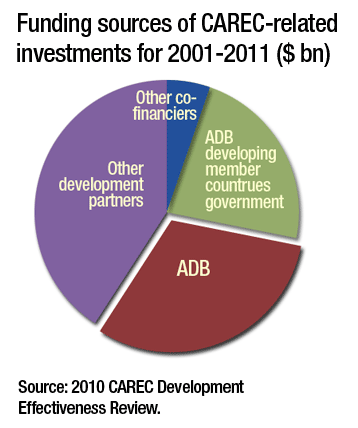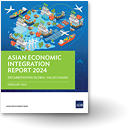Jul
2011
The Central Asia Regional Economic Cooperation (CAREC)

The Central Asia Regional Economic Cooperation (CAREC) Program is a partnership of 10 countries and six multilateral institutions promoting development through regional economic cooperation. CAREC proactively facilitates practical, results-based regional projects and policy initiatives in transport, energy, trade facilitation, and trade policy. ADB serves as the CAREC Secretariat, and provides financial and technical support in the implementation of priority regional projects and initiatives.
CAREC is present across the region building transport and energy infrastructure, simplifying border and trade arrangements, and undertaking capacity building and knowledge sharing on priority sectors and themes through the work of the CAREC Institute.Recent Developments
- Almost $10 billion has been committed through ADB’s multi-tranche financing facility (MFF) mechanism in the CAREC transport and energy sectors. To date, nearly $3 billion has been implemented through approval of 16 tranches of the CAREC MFFs.
 2011 marks CAREC’s 10 years of institutional cooperation. Activities include (i) a 10-year strategic framework (CAREC 2020) and a 10?year study on CAREC achievements; (ii) convening of a development partner’s forum; and (iii) production of a commemorative video on CAREC achievements.
2011 marks CAREC’s 10 years of institutional cooperation. Activities include (i) a 10-year strategic framework (CAREC 2020) and a 10?year study on CAREC achievements; (ii) convening of a development partner’s forum; and (iii) production of a commemorative video on CAREC achievements.- A Senior Officials’ Meeting was convened in Baku, Azerbaijan in June to review the draft CAREC 2020 strategy paper. An integral part of CAREC 2020 is a list of medium?term high?priority CAREC projects in the core sectors of cooperation. CAREC 2020 is expected to be endorsed by the 10th Ministerial Conference to be held in Baku in November.
The views expressed in this blog post are the views of the author and do not necessarily reflect the views or policies of ARIC, the Asian Development Bank (ADB), its Board of Directors, or the governments they represent. ARIC does not guarantee the accuracy of the information and data included in this blog post and accepts no responsibility for any consequences of their use. Terminology used may not necessarily be consistent with official ADB terms.




